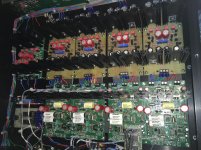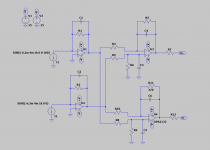Ithink this has been discussed before in this forum. It's not a very good low impedance path. The impedance varies with frequency (a lot!).
Could you please give me some links about that discusstion? I have searched the forum and found nothing. Thanks a lot!
Could you please give me some links about that discusstion? I have searched the forum and found nothing. Thanks a lot!
I couldn't find it either. However, you may search "Low input impedance current-to-voltge conversion circuit for Current-output digital-to-analog converters" and read the paper from AES.
Could you please give me some links about that discusstion? I have searched the forum and found nothing. Thanks a lot!
I think it will help to look at tech literature for transimpedance with cfa, e.g., Compensating Current Feedback Amplifiers in Photocurrent Applications | Analog Devices
Thanks for the information. I found a PDF and attached here.
The openloop inverting input impendence contribution very little to the closed loop operation while the feedback effectiveness domaining. The CFA OP drops fewer open loop gain when frequency goes up, so it can outperform VFB OP in the I/V convertion.(Even if we use a better VFB instand of AD845,things won`t change too much:just look at open loop gain VS freq. plot.)
Distortion did`t mentioned in this article. If we only focus on input impendence \freq. respond\, we can find a well designed discrete I/V is the best, then comes CFA OP.
So many years have passed since this thread first posted.
The openloop inverting input impendence contribution very little to the closed loop operation while the feedback effectiveness domaining. The CFA OP drops fewer open loop gain when frequency goes up, so it can outperform VFB OP in the I/V convertion.(Even if we use a better VFB instand of AD845,things won`t change too much:just look at open loop gain VS freq. plot.)
Distortion did`t mentioned in this article. If we only focus on input impendence \freq. respond\, we can find a well designed discrete I/V is the best, then comes CFA OP.
So many years have passed since this thread first posted.
Attachments
Surely you don't mean a FET-input opamp for I/V? Lots more modern parts than the AD811, as good as it was in its prime.
With 8 x 1704K I have 4 Borbely discrete jfet IV stages , it also acts as the output buffer with 85 ma bias on the output mosfets so just a single analog stage for each phase. 10 discrete jfet shunt regulators and the dac board ( not in the picture).
Uses 2sk389/2sj109 , 2sk170/2sj74, 313/2013 mosFets - all the hard to find parts.
over 50 Blackgate caps, teflon caps, nude tX2575 Vishay, silver wire, everything I could find that flat earthers think is a waste of money. With Highdef downloads it’s very , very nice.
Uses 2sk389/2sj109 , 2sk170/2sj74, 313/2013 mosFets - all the hard to find parts.
over 50 Blackgate caps, teflon caps, nude tX2575 Vishay, silver wire, everything I could find that flat earthers think is a waste of money. With Highdef downloads it’s very , very nice.
Attachments
Last edited:
So how about current output multiBits delta-sigma DACs? What shall we look at when choosing the I/V stage opamps? All newer DACs are based on this architecture.
For example, what slew rate and settling time should be fine? All the discusses at the beginning of the thread are focus on older DACs.
For example, what slew rate and settling time should be fine? All the discusses at the beginning of the thread are focus on older DACs.
So how about current output multiBits delta-sigma DACs? What shall we look at when choosing the I/V stage opamps? All newer DACs are based on this architecture.
Audio DACs gave up current outputs (i.e. high-impedance outs like AD1955, PCM1792) and went over to resistor arrays quite some time ago. The resistor values have been decreasing over time (e.g. ES9018 --> ES9038) in pursuit of lower noise so in a sense they've been becoming less current output over that same time. Sure the manufacturers recommend terminating them in a virtual short for lowest distortion but that's a different matter from being 'current output'.
Audio DACs gave up current outputs (i.e. high-impedance outs like AD1955, PCM1792) and went over to resistor arrays quite some time ago. The resistor values have been decreasing over time (e.g. ES9018 --> ES9038) in pursuit of lower noise so in a sense they've been becoming less current output over that same time. Sure the manufacturers recommend terminating them in a virtual short for lowest distortion but that's a different matter from being 'current output'.
The true current OP PCM179x family have *very* fast current step rise times. Effective RF energy way >100MHz. The newer unity weighted resistor
architecture DACs appear to be less demanding WRT OP edge rates but more
demanding WRT lower OP Z.
T
Thanks. We do need to consider the DAC chips before we talk about the I/V stage.
Here`s two newest dacs. ak4499 has a SR output as mentioned with a 64ohm output impendence and much higher current.
Here`s two newest dacs. ak4499 has a SR output as mentioned with a 64ohm output impendence and much higher current.
Attachments
Last edited:
Did the delta-sigma modulator changed something in these years? Say ak4499 has a 3 order delta-sigma modulator. The earlier types may only have a two-order one?
Just introduce a new option for this.THS3491. CFA.Very high Transinpendence and very fast. If you can accept the distortion of LMH6172, it can be considered.
The classic AD811 still have no alternative at this moment. LME49713 has been discontinued.
The classic AD811 still have no alternative at this moment. LME49713 has been discontinued.
A big problem of the new dacs (say es9038pro, ak4499eq)is they have very high output current,which is good for SNR, but makes harder for CFA ops for I/V stage,since they may need a relatively big feedback resistor value which may cause Vout running too high.
This is a pity!
This is a pity!
Just introduce a new option for this.THS3491. CFA.Very high Transinpendence and very fast. If you can accept the distortion of LMH6172, it can be considered.
The classic AD811 still have no alternative at this moment. LME49713 has been discontinued.
We found AD811 didn't sound as good as other options and yes, it was correctly
bypassed. The problem with CF opamps for I-V is that if you wish to place the
first pole of LPF around I-V opamp, as is the usual practice, it will require
an additional resistor feeding into - IP to retain stability. Adding this resistor will
increase the distortion and CF opa's already have higher distortion than VFB
OPA's.
One can always get pretty hairy and use a common-gate/base discrete with a opamp sitting right behind it (and feed back into the source/emitter, IIRC) if you want/need to handle currents beyond reasonable for an opamp-based I/V. 😀
Surely you don't mean a FET-input opamp for I/V? Lots more modern parts than the AD811, as good as it was in its prime.
... ahhhhh those fets...
I realized I flipped AD811 and AD711 above in terms of FET-input (apologies!)
- Home
- Source & Line
- Digital Line Level
- Best opamp for I/V conversion? (DAC)

